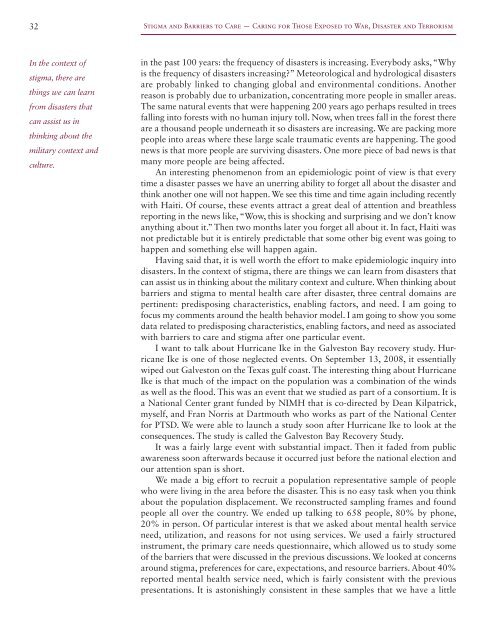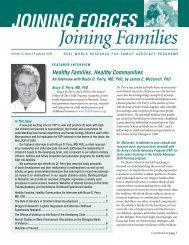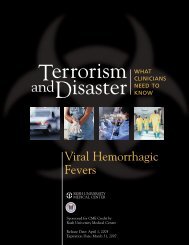stigma and barriers to care - Uniformed Services University of the ...
stigma and barriers to care - Uniformed Services University of the ...
stigma and barriers to care - Uniformed Services University of the ...
You also want an ePaper? Increase the reach of your titles
YUMPU automatically turns print PDFs into web optimized ePapers that Google loves.
32<br />
Stigma <strong>and</strong> Barriers <strong>to</strong> Care — Caring for Those Exposed <strong>to</strong> War, Disaster <strong>and</strong> Terrorism<br />
In <strong>the</strong> context <strong>of</strong><br />
<strong>stigma</strong>, <strong>the</strong>re are<br />
things we can learn<br />
from disasters that<br />
can assist us in<br />
thinking about <strong>the</strong><br />
military context <strong>and</strong><br />
culture.<br />
in <strong>the</strong> past 100 years: <strong>the</strong> frequency <strong>of</strong> disasters is increasing. Everybody asks, “Why<br />
is <strong>the</strong> frequency <strong>of</strong> disasters increasing” Meteorological <strong>and</strong> hydrological disasters<br />
are probably linked <strong>to</strong> changing global <strong>and</strong> environmental conditions. Ano<strong>the</strong>r<br />
reason is probably due <strong>to</strong> urbanization, concentrating more people in smaller areas.<br />
The same natural events that were happening 200 years ago perhaps resulted in trees<br />
falling in<strong>to</strong> forests with no human injury <strong>to</strong>ll. Now, when trees fall in <strong>the</strong> forest <strong>the</strong>re<br />
are a thous<strong>and</strong> people underneath it so disasters are increasing. We are packing more<br />
people in<strong>to</strong> areas where <strong>the</strong>se large scale traumatic events are happening. The good<br />
news is that more people are surviving disasters. One more piece <strong>of</strong> bad news is that<br />
many more people are being affected.<br />
An interesting phenomenon from an epidemiologic point <strong>of</strong> view is that every<br />
time a disaster passes we have an unerring ability <strong>to</strong> forget all about <strong>the</strong> disaster <strong>and</strong><br />
think ano<strong>the</strong>r one will not happen. We see this time <strong>and</strong> time again including recently<br />
with Haiti. Of course, <strong>the</strong>se events attract a great deal <strong>of</strong> attention <strong>and</strong> breathless<br />
reporting in <strong>the</strong> news like, “Wow, this is shocking <strong>and</strong> surprising <strong>and</strong> we don’t know<br />
anything about it.” Then two months later you forget all about it. In fact, Haiti was<br />
not predictable but it is entirely predictable that some o<strong>the</strong>r big event was going <strong>to</strong><br />
happen <strong>and</strong> something else will happen again.<br />
Having said that, it is well worth <strong>the</strong> effort <strong>to</strong> make epidemiologic inquiry in<strong>to</strong><br />
disasters. In <strong>the</strong> context <strong>of</strong> <strong>stigma</strong>, <strong>the</strong>re are things we can learn from disasters that<br />
can assist us in thinking about <strong>the</strong> military context <strong>and</strong> culture. When thinking about<br />
<strong>barriers</strong> <strong>and</strong> <strong>stigma</strong> <strong>to</strong> mental health <strong>care</strong> after disaster, three central domains are<br />
pertinent: predisposing characteristics, enabling fac<strong>to</strong>rs, <strong>and</strong> need. I am going <strong>to</strong><br />
focus my comments around <strong>the</strong> health behavior model. I am going <strong>to</strong> show you some<br />
data related <strong>to</strong> predisposing characteristics, enabling fac<strong>to</strong>rs, <strong>and</strong> need as associated<br />
with <strong>barriers</strong> <strong>to</strong> <strong>care</strong> <strong>and</strong> <strong>stigma</strong> after one particular event.<br />
I want <strong>to</strong> talk about Hurricane Ike in <strong>the</strong> Galves<strong>to</strong>n Bay recovery study. Hurricane<br />
Ike is one <strong>of</strong> those neglected events. On September 13, 2008, it essentially<br />
wiped out Galves<strong>to</strong>n on <strong>the</strong> Texas gulf coast. The interesting thing about Hurricane<br />
Ike is that much <strong>of</strong> <strong>the</strong> impact on <strong>the</strong> population was a combination <strong>of</strong> <strong>the</strong> winds<br />
as well as <strong>the</strong> flood. This was an event that we studied as part <strong>of</strong> a consortium. It is<br />
a National Center grant funded by NIMH that is co-directed by Dean Kilpatrick,<br />
myself, <strong>and</strong> Fran Norris at Dartmouth who works as part <strong>of</strong> <strong>the</strong> National Center<br />
for PTSD. We were able <strong>to</strong> launch a study soon after Hurricane Ike <strong>to</strong> look at <strong>the</strong><br />
consequences. The study is called <strong>the</strong> Galves<strong>to</strong>n Bay Recovery Study.<br />
It was a fairly large event with substantial impact. Then it faded from public<br />
awareness soon afterwards because it occurred just before <strong>the</strong> national election <strong>and</strong><br />
our attention span is short.<br />
We made a big effort <strong>to</strong> recruit a population representative sample <strong>of</strong> people<br />
who were living in <strong>the</strong> area before <strong>the</strong> disaster. This is no easy task when you think<br />
about <strong>the</strong> population displacement. We reconstructed sampling frames <strong>and</strong> found<br />
people all over <strong>the</strong> country. We ended up talking <strong>to</strong> 658 people, 80% by phone,<br />
20% in person. Of particular interest is that we asked about mental health service<br />
need, utilization, <strong>and</strong> reasons for not using services. We used a fairly structured<br />
instrument, <strong>the</strong> primary <strong>care</strong> needs questionnaire, which allowed us <strong>to</strong> study some<br />
<strong>of</strong> <strong>the</strong> <strong>barriers</strong> that were discussed in <strong>the</strong> previous discussions. We looked at concerns<br />
around <strong>stigma</strong>, preferences for <strong>care</strong>, expectations, <strong>and</strong> resource <strong>barriers</strong>. About 40%<br />
reported mental health service need, which is fairly consistent with <strong>the</strong> previous<br />
presentations. It is as<strong>to</strong>nishingly consistent in <strong>the</strong>se samples that we have a little




